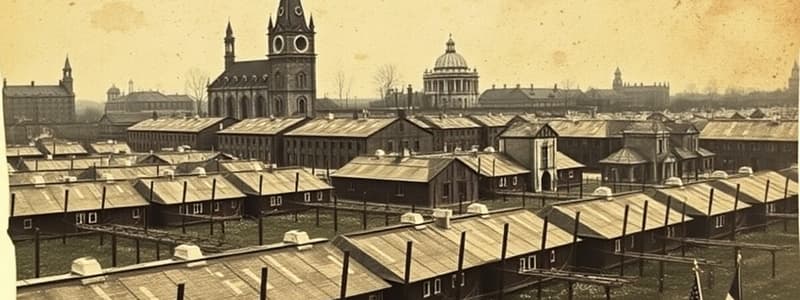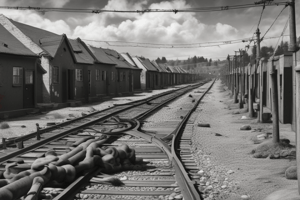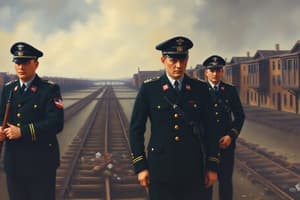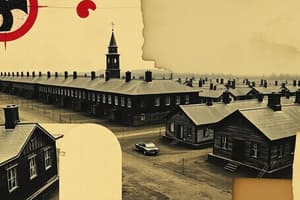Podcast
Questions and Answers
What was the primary purpose of the initial abuse inflicted upon prisoners during transportation to concentration camps?
What was the primary purpose of the initial abuse inflicted upon prisoners during transportation to concentration camps?
- To segregate prisoners based on their perceived threat level.
- To instill fear and shame, thereby dehumanizing them. (correct)
- To ensure prisoners were physically exhausted upon arrival.
- To identify prisoners with pre-existing medical conditions.
Upon arrival at a concentration camp, all prisoners were immediately assigned to labor duties.
Upon arrival at a concentration camp, all prisoners were immediately assigned to labor duties.
False (B)
What was the significance of assigning numbers to prisoners in concentration camps?
What was the significance of assigning numbers to prisoners in concentration camps?
Prisoners' names were replaced with prison numbers as part of the dehumanization process, stripping them of their individuality and identity.
Prisoners were constantly watched by German soldiers and the camp structure mimicked Dachau. The camp was led by a ______.
Prisoners were constantly watched by German soldiers and the camp structure mimicked Dachau. The camp was led by a ______.
Match the following roles with their descriptions within the concentration camp hierarchy:
Match the following roles with their descriptions within the concentration camp hierarchy:
What was the primary purpose of the colored triangle badges assigned to prisoners?
What was the primary purpose of the colored triangle badges assigned to prisoners?
Prisoners in concentration camps typically had access to adequate bedding and blankets.
Prisoners in concentration camps typically had access to adequate bedding and blankets.
Describe the typical daily ration provided to prisoners and its impact on their health.
Describe the typical daily ration provided to prisoners and its impact on their health.
Prisoners had to perform heavy labor for up to 14 hours a day under constant guard surveillance. They were beaten for moving too slowly or without permission, leading to death from overwork, beatings, execution, or ______.
Prisoners had to perform heavy labor for up to 14 hours a day under constant guard surveillance. They were beaten for moving too slowly or without permission, leading to death from overwork, beatings, execution, or ______.
Match the following diseases with their common causes in concentration camps:
Match the following diseases with their common causes in concentration camps:
What was 'The Appel,' and why was it significant in the daily life of prisoners?
What was 'The Appel,' and why was it significant in the daily life of prisoners?
During 'The Appel,' the bodies of prisoners who died overnight were promptly removed and treated with respect.
During 'The Appel,' the bodies of prisoners who died overnight were promptly removed and treated with respect.
Describe the conditions under which prisoners had to perform 'bettenbau' and the consequences of failure.
Describe the conditions under which prisoners had to perform 'bettenbau' and the consequences of failure.
After the morning roll all, prisoners were marched to work sites and forced to sing degrading songs for the guards' amusement. Falling behind meant ______.
After the morning roll all, prisoners were marched to work sites and forced to sing degrading songs for the guards' amusement. Falling behind meant ______.
Match the following descriptions with the terms used in concentration camps:
Match the following descriptions with the terms used in concentration camps:
What would happen if the prisoner counts were inaccurate during roll call?
What would happen if the prisoner counts were inaccurate during roll call?
Prisoners were typically given generous amounts of free time in the barracks to rest and recover after work.
Prisoners were typically given generous amounts of free time in the barracks to rest and recover after work.
What was the significance of the green triangles worn by Blockfuehrers?
What was the significance of the green triangles worn by Blockfuehrers?
Lack of essential medical facilities meant falling sick often led to a grim fate. Sick bays or infirmaries were often inadequate, lacking basic necessities. Fellow inmates sometimes ran sick bays, but efforts were largely futile due to rampant diseases, conditions, and ______.
Lack of essential medical facilities meant falling sick often led to a grim fate. Sick bays or infirmaries were often inadequate, lacking basic necessities. Fellow inmates sometimes ran sick bays, but efforts were largely futile due to rampant diseases, conditions, and ______.
Match the following conditions with their descriptions within concentration camp infirmaries:
Match the following conditions with their descriptions within concentration camp infirmaries:
What did prisoners do to maintain hope and humanity in the concentration camps?
What did prisoners do to maintain hope and humanity in the concentration camps?
Journals, diaries, artworks, and jewelry crafted from copper wire served as testimonials to life in concentration camps.
Journals, diaries, artworks, and jewelry crafted from copper wire served as testimonials to life in concentration camps.
How did the daily life and treatment in Nazi concentration camps affect the prisoners sense of self?
How did the daily life and treatment in Nazi concentration camps affect the prisoners sense of self?
Despite attempts to extinguish their identities, prisoners displayed remarkable ______ and humanity.
Despite attempts to extinguish their identities, prisoners displayed remarkable ______ and humanity.
Match the following terms with their role in the aftermath of the concentration camps:
Match the following terms with their role in the aftermath of the concentration camps:
What is the legacy of the Holocaust meant to serve as?
What is the legacy of the Holocaust meant to serve as?
Liberation erased the trauma from the minds of those affected and the world.
Liberation erased the trauma from the minds of those affected and the world.
Discuss what it was like for survivors who faced rebuilding their lives.
Discuss what it was like for survivors who faced rebuilding their lives.
The Holocaust's legacy serves as a reminder of the consequences of ______, urging future generations to remember the past and strive for a world free from such horrors.
The Holocaust's legacy serves as a reminder of the consequences of ______, urging future generations to remember the past and strive for a world free from such horrors.
Match the following aspects of the Holocaust with their significance:
Match the following aspects of the Holocaust with their significance:
Flashcards
Capture and Arrest
Capture and Arrest
SS officers forcibly remove individuals from their homes based on various discriminatory criteria.
Dehumanization
Dehumanization
The act of depriving someone of their humanity and individuality.
Arrival Selection
Arrival Selection
Prisoners arriving were divided into groups, and assessed for their ability to work, or sent for immediate execution.
Camp Structure
Camp Structure
Signup and view all the flashcards
Kapos
Kapos
Signup and view all the flashcards
Prisoner Badges
Prisoner Badges
Signup and view all the flashcards
The Appel
The Appel
Signup and view all the flashcards
Appellplatz
Appellplatz
Signup and view all the flashcards
Blockfuehrers
Blockfuehrers
Signup and view all the flashcards
Inadequate Healthcare
Inadequate Healthcare
Signup and view all the flashcards
Daily Life
Daily Life
Signup and view all the flashcards
Maintaining Hope
Maintaining Hope
Signup and view all the flashcards
Study Notes
Capture and Initial Treatment
- SS officers broke into homes and rounded up "undesirables"
- Those captured were arrested for opposing the Nazis, belonging to undesired groups (homeless, LGBTQ+, mentally ill, criminals), for religious beliefs, or for being of Jewish ethnicity
- The journey to the camp was dehumanizing, instilling fear and shame via abuse
- Jews of all ages were transported in overcrowded vehicles (trains/trucks) in terror
- Conditions were cramped, without food, water, or toilet facilities; buckets were used for waste
- Journeys could take days and were filled with starvation, dehydration, claustrophobia, and uncertainty
- Families were often separated, and their fates were unknown
- Prisoners were given no information about their destination, increasing fear
Arrival and Selection
- Upon arrival, prisoners were divided into groups (men and women with children)
- SS guards demanded age, occupation, and health condition in a macabre welcome
- Based on answers, prisoners were deemed fit for work (right) or for immediate execution (left)
- Those deemed "unfit for work" (sick, old, young) were sent to gas chambers
Dehumanization Process
- After selection, prisoners were stripped of their belongings
- Possessions were taken, never to be returned
- Prisoners were registered into the camp system; names were replaced with prison numbers
- Numbers were sometimes tattooed on arms (especially at Auschwitz)
- Heads were shaved regardless of gender
- Prisoners were forced to shower in groups while guards watched
Camp Hierarchy and Living Conditions
- Prisoners were constantly watched by German soldiers
- Camp structure mimicked Dachau: led by Lagerkommandant and junior officers
- Prisoners also had a hierarchy: Kapos (prisoner-supervisors)
- Prisoners were assigned colored triangle badges to identify reasons for imprisonment
- Barracks were overcrowded, designed for fewer people than were housed there
- Bunks were tiny, often tiered, and placed on muddy floors
- Limited space required multiple prisoners to share bunks (up to 6 per tier)
- A lack of bunks forced prisoners to sleep in tents or damp tunnels
- No bedding or blankets were provided, except for straw mattresses (rarely replaced)
- Poor sanitation led to lice, rats, and vermin, thus facilitating disease spread
- Diseases spread quickly due to unsanitary conditions
Sustenance and Labor
- Meager rations: watery soup, stale bread, an occasional small piece of sausage/cheese
- Constant hunger weakened bodies and left prisoners vulnerable
- Prisoners performed heavy labor (construction, quarrying, trench digging, factory work)
- Workdays were grueling (up to 14 hours), under constant guard surveillance
- Prisoners were beaten for moving too slowly or without permission
- Death resulted from overwork, beatings, execution, or medical experiments
Health and Hygiene
- The anti-Semitic regime denied basic medical attention
- Minor injuries festered, and grave illnesses became fatal sentences
- Common diseases included typhus, dysentery, and tuberculosis
- Mental toll: depression, hopelessness, and despair were common
Daily Routine: The Appel
- The daily routine began with The Appel (morning and evening lineup) in all weather
- Prisoners were awoken between 4 am and 4:30 am by loud gongs and Kapos yelling
- Bodies of those who died overnight were often ignored
- Prisoners might experience "bettenbau" (bed-making) under strict SS rules
- Failure resulted in beatings, sometimes to death
- Dirty water was used for cleaning without soap or toiletries
- Breakfast was an unappetizing meal of stale bread with watered-down tea or coffee
- Kapos might single out prisoners, throwing bread in the mud or spilling coffee
- Appel or Appellplatz: daily morning roll call
- Prisoners stood in rigid rows of ten, and were counted by Kapos under SS watch
- Any movement resulted in swift and brutal punishment
- The counting process was repeated, forcing prisoners to stand for hours
- Attempts to evade The Appel resulted in beatings, torture, or death
- After the roll call, prisoners were marched to work sites (a short walk to several miles)
- They were forced to sing degrading songs for the guards' amusement
- Falling behind meant severe punishment
- Afternoon roll call
- Lunch was either consumed or brought to work stations
- Labor ended, potentially throughout the entire night
End of Workday and Return to Camp
- Prisoners were marched back to camp for the final roll call after work
- Deceased prisoners were carried back by fellow inmates for the evening roll call to maintain accurate numbers
- Inaccurate prisoner counts could cause roll call to last for hours, sometimes intentionally as a form of punishment
Dinner and Free Time
- Prisoners who survived the day without collapsing or facing severe punishment received a meager dinner, often watery vegetable soup, served in mess tins
- In some camps, dinner was nonexistent, and prisoners went straight to the barracks after labor
- Free time in the barracks was used for bartering items among the prisoners
- Prisoners were expected to retire to their barracks after dinner, with lights out typically by 9 pm, but sometimes later
- Leaving the barracks at night was strictly prohibited, with Blockfuehrers and guards constantly patrolling
Blockfuehrers
- Blockfuehrers, also known as Death Heads, wore green triangles on their uniforms, signifying them as "real criminals" with the power to determine prisoners' fates
- Blockfuehrers decided who lived or died as punishment for prisoners caught outside during bedtime
- Retreating to the barracks meant surviving another day, but also facing the same ordeals again
Medical Facilities and Healthcare
- A lack of essential medical facilities meant falling sick often led to a grim fate
- Sick bays or infirmaries were often inadequate, lacking basic necessities
- Fellow inmates sometimes ran sick bays, but efforts proved largely futile due to rampant diseases, conditions, and shortages
- Infirmaries typically lacked water, plumbing, and electricity, with dirty cots and straw mattresses covered in pus and blood
- Each mattress often held at least two sick people, sometimes skeletal, and covered in scabies, boils, lice, or completely naked
- Disease outbreaks often led to more than two sick individuals sharing a mattress, shivering from the cold and suffering while waiting for help or death
Maintaining Hope and Humanity
- Prisoners held onto hope and tried to maintain cultural and religious activities
- Journals, diaries, artworks, and jewelry crafted from copper wire served as testimonials to life in the concentration camps
- These works acted as grim reminders of resilience and humanity amidst cruelty, retaining shreds of identity
Daily Life and Treatment
- Life in Nazi concentration camps was a routine nightmare, marked by relentless brutality, dehumanizing routines, and constant fear
- The daily struggle for survival was marked by the brutality of SS guards and the constant fear of punishment or death
- Despite attempts to extinguish their identities, prisoners displayed remarkable strength and humanity
- Their stories serve as reminders of the human spirit's ability to endure extreme circumstances, presenting hope in the bleakest times
Liberation and Aftermath
- Prisoners endured their nightmare until rescued by Allied forces, which marked the beginning of the end of their suffering
- Liberation couldn't erase the trauma from the minds of those affected and the world
- Survivors faced rebuilding their lives, grappling with trauma, and pursuing justice
- The Holocaust's legacy serves as a reminder of the consequences of unchecked hatred, urging future generations to remember the past and strive for a world free from such horrors
Studying That Suits You
Use AI to generate personalized quizzes and flashcards to suit your learning preferences.




